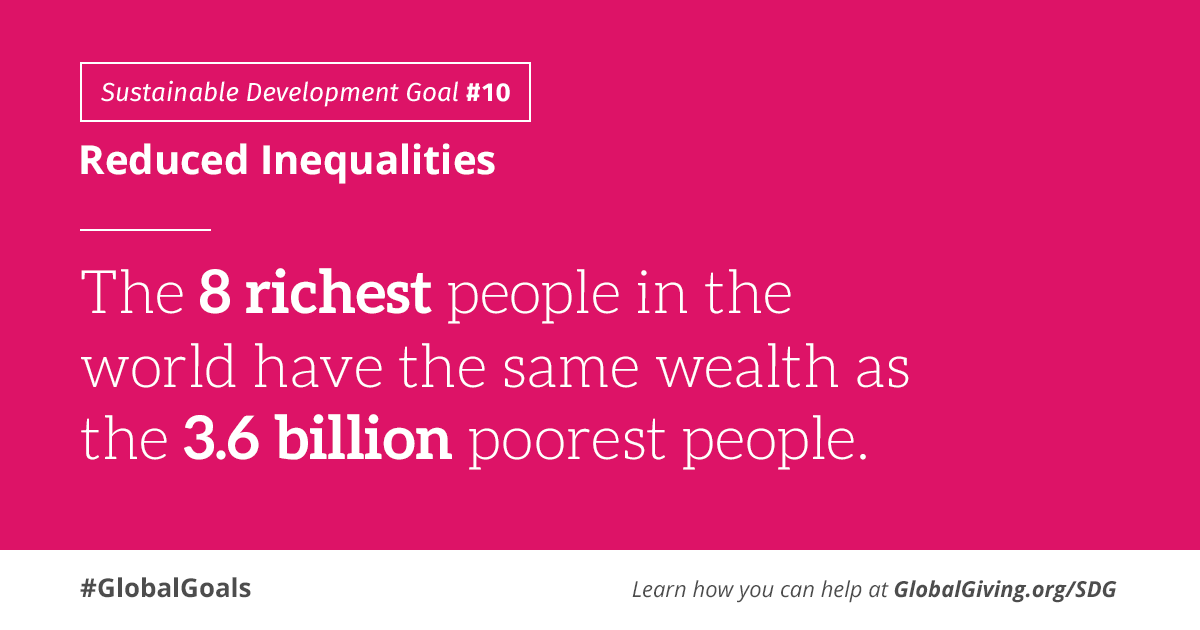
The Challenge
The international community has made significant strides towards lifting people out of poverty. The most vulnerable nations – the least developed countries, the landlocked developing countries and the small island developing states – continue to make inroads into poverty reduction. However, large disparities remain in access to health and education services and other assets within these countries. While income inequality between countries may have been reduced, inequality within countries has risen.
In 2017, the richest 1% of the world’s population held 50.1% of the world’s wealth, while the poorest 70% of the world’s working age population people together hold only 2.7% of the global wealth. The imbalance is put into stark relief when one considers that a total of 36 million millionaires, who account for 0.7% of the world’s adult population – control 46% of total global wealth that now stands at $280tn. The world’s 10 richest billionaires, according to Forbes, own $505 billion in combined wealth, a sum greater than the total goods and services most nations produce on an annual basis.
“BY 2030 NOBODY WILL LIVE IN EXTREME POVERTY ANYWHERE IN THE WORLD”

Why is this important?
Inequality is a roadblock to progress when it deprives people of opportunity, and subjects many to conditions of extreme poverty. For instance, in the late 2000s in children in the wealthiest quintile of South Asia were two times more likely to complete primary school than those in the poorest. In Latin America and East Asia, children in the poorest asset quintile are three times more likely to die before the age of 5 than those in the richest. There is growing consensus that economic growth is not sufficient to reduce poverty if it is not inclusive and if it does not involve the three dimensions of sustainable development – economic, social and environmental. Rising inequalities adversely impact human development. According to the inequality-adjusted Human Development Index (HDI), Sub-Saharan Africa loses 33% of its HDI to inequality and South Asia by 25%.
What can we do to address this?
Goal 10 presents to the international community the following task: ensure that the income growth of the bottom 40% of their population is higher than the national average by the year 2030. To reduce inequality, policies should be universal in principle, paying attention to the needs of disadvantaged and marginalised populations. Inclusion has to be promoted actively, in social as well as political spheres, for all ages, sexes, races, religions and ethnicities to create conditions of equity within countries. To create a fairer international system globally, global financial markets will require improved regulation, and developing countries will have to have a greater voice in international decision making.

India and Goal 10
The Gini coefficient of income inequality for India fell from 36.8% in 2010 to 33.6% in 2015. The Government of India’s emphasis on the three pronged Jan Dhan-Aadhaar-Mobile programmes are aimed at a comprehensive strategy of inclusion, financial empowerment and social security. These priorities are in line with the Sustainable Development targets aimed at achieving greater equality and promoting the social, economic, and political inclusion of all by 2030.

Targets
- By 2030, progressively achieve and sustain income growth of the bottom 40% of the population at a rate higher than the national average.
- By 2030, empower and promote the social, economic and political inclusion of all, irrespective of age, sex, disability, race, ethnicity, origin, religion or economic or other status.
- Ensure equal opportunity and reduce inequalities of outcome, including by eliminating discriminatory laws, policies and practices and promoting appropriate legislation, policies and action in this regard.
- Adopt policies, especially fiscal, wage and social protection policies, and progressively achieve greater equality.
- Improve the regulation and monitoring of global financial markets and institutions and strengthen the implementation of such regulations.
- Ensure enhanced representation and voice for developing countries in decision-making in global international economic and financial institutions in order to deliver more effective, credible, accountable and legitimate institutions.
- Facilitate orderly, safe, regular and responsible migration and mobility of people, including through the implementation of planned and well-managed migration policies.
- Implement the principle of special and differential treatment for developing countries, in particular least developed countries, in accordance with World Trade Organization agreements.
- Encourage official development assistance and financial flows, including foreign direct investment, to states where the need is greatest, in particular least developed countries, African countries, small island developing states and land-locked developing countries, in accordance with their national plans and programmes.
- By 2030, reduce to less than 3% the transaction costs of migrant remittances and eliminate remittance corridors with costs higher than 5%.
